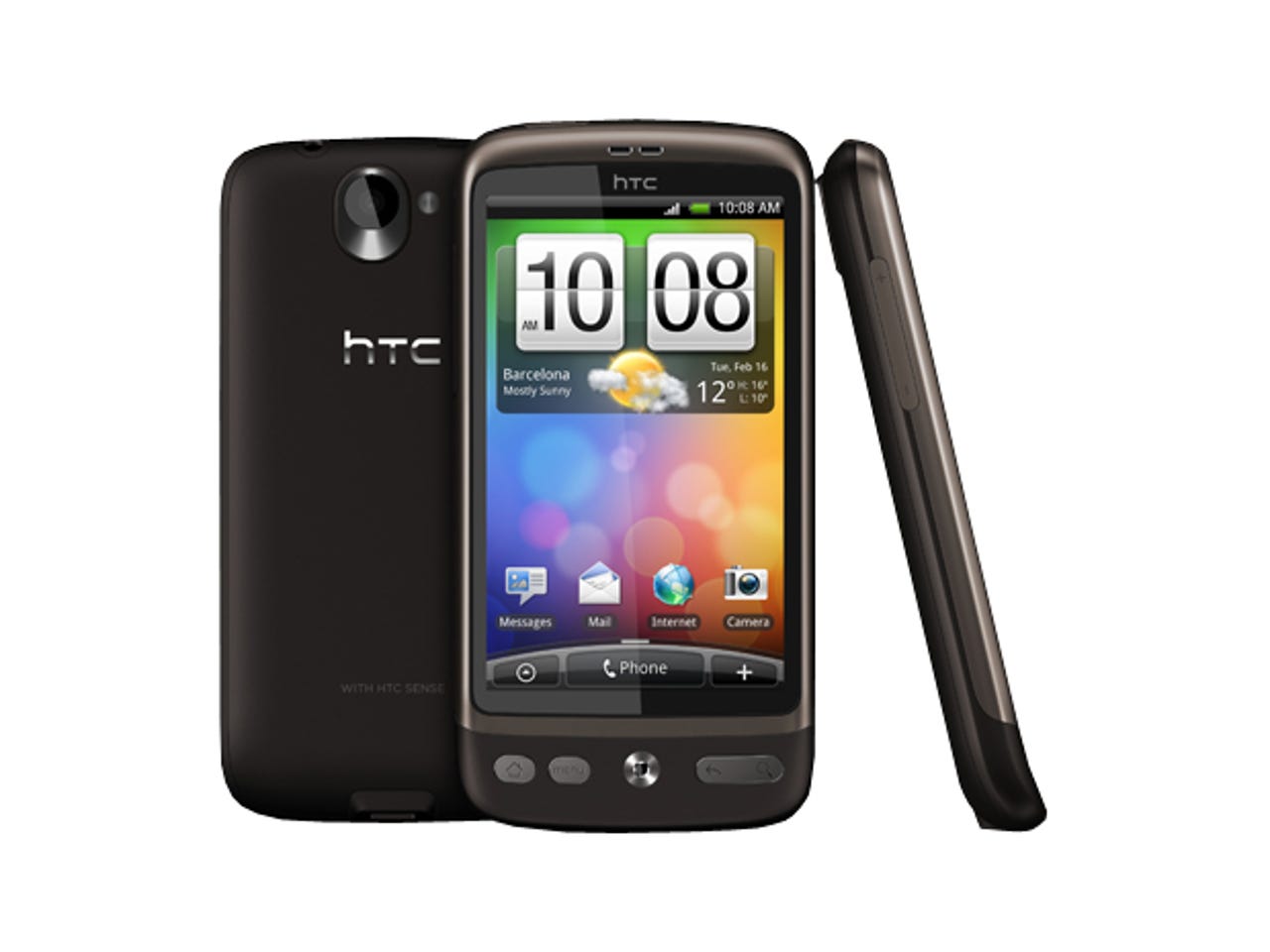HTC Desire


We recently reviewed the HTC Legend, a generally impressive Android 2.1 smartphone whose only real drawback was its disappointing battery life. We've now got our hands on the HTC Desire, a higher-spec device with a higher price tag (£439.99 inc. VAT from Expansys). Does it put the Legend in the shade?
Design
The HTC Desire measures 60mm wide by 119mm tall by 11.9mm thick and weighs 135g. This makes it significantly bigger than its Legend stablemate (56.3mm x 112mm x 11.5mm), which is itself very similar to the Hero that it supersedes (56.2mm x 112mm x 14.35mm).
HTC Desire: Android 2.1 and HTC's Sense interface plus a 1GHz CPU and a 3.7in. AMOLED screen
The Desire accommodates a large 3.7in. screen — although it's not as large as that of HTC's Windows Mobile 6.5-based HD2 whose 4.3in. display is the largest we've come across. The Desire's AMOLED screen is superb, though: capacitive technology makes it very responsive to finger sweeps, presses and pinches, while its 480-by-800-pixel resolution renders it ideal for web browsing and other media-rich tasks.
The screen's AMOLED technology makes for a sharp and bright display, with superb viewing angles — as long as you stay inside. We found it fine to read outdoors on fairly dull days, but not so good in bright sunshine.
The screen is large enough to present a QWERTY keyboard that's tappable with a high degree of accuracy even when the screen is in portrait mode. Turn the HTC Desire in your hand and the screen flips into landscape mode, presenting an even larger QWERTY keyboard on which we were quickly able to achieve over 90 percent of our top typing speed on this kind of keyboard.
The Desire's two-tone slate grey colour scheme is unremarkable, although we're pleased to see that the backplate has a rubberised finish that helps with grip — particularly when you're using the device one-handed. HTC has found room for a standard backplate (as opposed to the small cover and slide-out battery arrangement of the HTC Legend). It's unfortunate that you have to remove the battery to get to the microSD expansion card slot. Not everyone will find this an issue, but those who like to hot-swap cards, for whatever reason, are unlikely to appreciate having to power down the device to change cards.
Two ports and two buttons adorn the edges of the Desire. There's a microUSB port for PC connection and battery charging at the bottom and a 3.5mm headset connector at the top — the ideal location, as there's minimal danger of an attached headset snagging your pocket. The buttons are an on/off switch on the top edge and a long, thin volume rocker on the left edge.
The Desire's control buttons are familiar from other HTC Android devices
Beneath the screen is the familiar arrangement of Android buttons: Home, Menu (for context-sensitive menus) and a rocker accessing Back and Search functions. In the middle is an optical trackpad that looks the same as the one in the HTC Legend. We initially thought this too small to be comfortable to use, but found it surprisingly responsive. It incorporates a press-to-select function.
The HTC Desire ships with an AC adapter, a PC connection cable and a one-piece stereo headset with inline music playback controls.
Features
The HTC Desire shares a number of features with its smaller Legend stablemate. , including 802.11 b/g Wi-Fi, Bluetooth 2.1, HSPA mobile broadband (7.2Mbps download, 2Mbps upload), GPS and a motion sensor. The phone is a quad-band GSM unit with GPRS and EDGE support.
Mobile email users can use both POP3/IMAP and Microsoft Exchange ActiveSync connections. Like the HTC Legend, the Desire supports password protection and remote data wipe.
The operating system is Android 2.1 ('Eclair'), with which HTC has integrated its own Sense user interface. This provides seven home screens, which you can populate with an array of widgets, application shortcuts, links to people, web bookmarks, folders and more.
Like the HTC Legend, the Desire sports a new system for navigating the seven home screens. You can sweep a finger to move between them, or — and this is the new bit -— pinch inwards to see all seven as small thumbnails, and then tap the one you want to have it open up full-screen. This is a lot faster than moving through the screens individually, although obviously it's optimised for one-handed use. HTC calls this the Leap view.
The Desire differs from the Legend in its 1GHz Snapdragon processor (the Legend's CPU runs at 600MHz). This helps the Desire zip around at lightning speed, and we never felt we were waiting for it to catch up with our screen taps. Zooming in and out of web pages using finger-pinching is particularly responsive. Memory is also somewhat expanded: there's 512MB of ROM on both devices, but the Desire provides 576MB of RAM to the Legend's 384MB.
Social networking is well catered for, with HTC's Twitter client, Peep, preinstalled along with the FriendStream app we saw on the Legend. This brings together Facebook and Flickr updates and tweets in one convenient place. Business users may get more value from the PDF and QuickOffice (Word, Excel, PowerPoint) document viewers.
The Desire's ability to automatically download contacts from Outlook, Facebook and Gmail and link them together is potentially useful, although the less organised among us may want to spend some time deduping and tidying up.
Other applications include an FM radio, a voice recorder, YouTube and Google Maps clients, an RSS feed reader (which HTC calls News), HTC's Footprints app for remembering GPS locations and tagged photos and a simple desk clock with alarms, timer and stopwatch. The Desire supports Flash, although our review sample was unwilling to let us watch the BBC's News 24 web site online.
The Desire also reprises the HTC Legend's ability to silence a call by turning the handset face-down on the table and reduce the ringer volume when you move the phone.
The HTC Desire has a 5-megapixel camera with autofocus and flash, with face detection added into the mix. It will also geotag photos. There's no quick-launch button for the camera on an edge of the handset, but a widget on the main screen gives reasonably fast access. The controls are all easily accessed from pop-out sidebars except for the LED flash, which has its own dedicated on-screen button. Immediately you've taken a photo it can be shared via Facebook, Flickr, email, MMS, HTC Peep (to Twitter), Picasa or transmitted to a nearby device over a Bluetooth connection.
Performance & battery life
We had no trouble making and taking calls on the HTC Desire, and sound quality and volume were both fine. We'd like the ringer to go louder as it's a little quiet for some situations, but that's our only real gripe with calls.
As ever with Android handsets, battery life is disappointing. If you don't use mobile broadband, Wi-Fi or GPS, and don't have the handset set to automatically check for email, Twitter updates and so on, you may get through more than a day between charges. But this high-spec handset would be severely hampered without these features, and if you use them regularly you'll probably need a power boost during the day as well as at the end of each day.
Conclusion
HTC's Desire is larger and more expensive than its Legend sibling, adding a faster processor, more memory and a larger screen. If you value these features, then the Desire is worth the outlay. If you don't need the extras, then the Legend is an excellent and more affordable alternative.